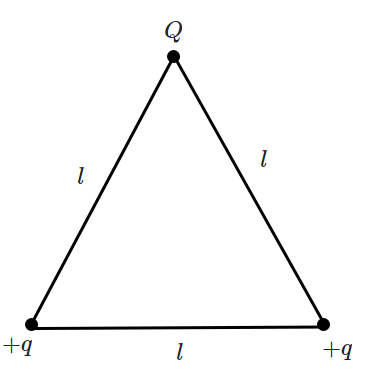The angle between equipotential surface and electric lines of force is:
1.
zero
2.
\(180^{\circ}\)
3.
\(90^{\circ}\)
4.
\(45^{\circ}\)
A charge +q is fixed at each of the points ..... infinite, on the x-axis, and a charge –q is fixed at each of the points ,..... infinite. Here x0 is a positive constant. Take the electric potential at a point due to a charge Q at a distance r from it to be . Then, the potential at the origin due to the above system of charges is:
1. 0
2.
3. ∞
4.
A conductor with a positive charge:
| 1. | is always at +ve potential. |
| 2. | is always at zero potential. |
| 3. | is always at negative potential. |
| 4. | may be at +ve, zero or –ve potential. |
On rotating a point charge having a charge \(q\) around a charge \(Q\) in a circle of radius \(r\), the work done will be:
| 1. | \(q \times2 \pi r\) | 2. | \(q \times2 \pi Q \over r\) |
| 3. | zero | 4. | \(Q \over 2\varepsilon_0r\) |
In the figure the charge Q is at the centre of the circle. Work done by the conservative force is maximum when another charge is taken from point P to:
| 1. | K | 2. | L |
| 3. | M | 4. | N |
What is the potential energy of two equal positive point charges of \(1~ \mu \text{C}\) each held \(1\) m apart in the air?
| 1. | \(9 \times 10^{-3}~\text{J}\) | 2. | \(9 \times 10^{-3}~\text{eV}\) |
| 3. | \(2~\text{eV/m}\) | 4. | zero |
Ten electrons are equally spaced and fixed around a circle of radius R. Relative to V = 0 at infinity, the electrostatic potential V and the electric field E at the centre C are:
| 1. | \(V \neq 0 \text { and } \vec{E} \neq 0\) |
| 2. | \(V \neq 0 \text { and } \vec{E}=0\) |
| 3. | \(V=0 \text { and } \vec{E}=0\) |
| 4. | \(V=0 \text { and } \vec{E} \neq 0\) |
A cube of a metal is given a positive charge Q. For the above system, which of the following statements is true?
| 1. | Electric potential at the surface of the cube is zero. |
| 2. | Electric potential within the cube is zero. |
| 3. | Electric field is normal to the surface of the cube. |
| 4. | Electric field varies within the cube. |
Three charges \(Q\), \(+q \) and \(+q \) are placed at the vertices of an equilateral triangle of side \(l\) as shown in the figure. If the net electrostatic energy of the system is zero, then \(Q\) is equal to:
| 1. | \(-\frac{q}{2} \) | 2. | \(-q\) |
| 3. | \(+q\) | 4. | \(\text{zero}\) |
A thin spherical conducting shell of radius R has a charge q. Another charge Q is placed at the centre of the shell. The electrostatic potential at a point p which is at a distance from the centre of the shell is:
1.
2.
3.
4.




